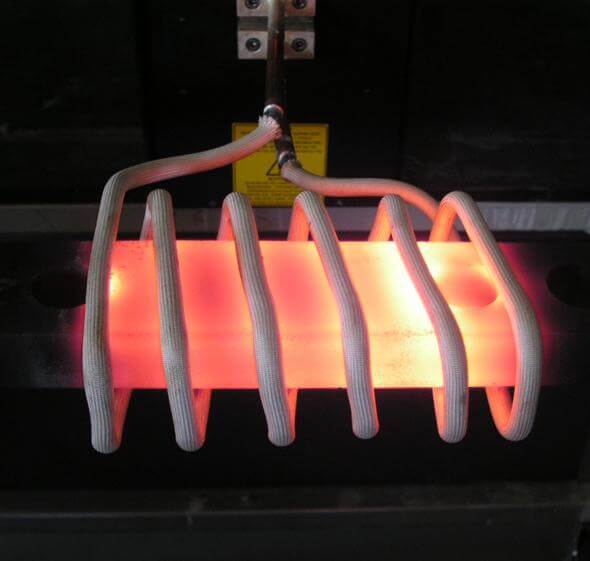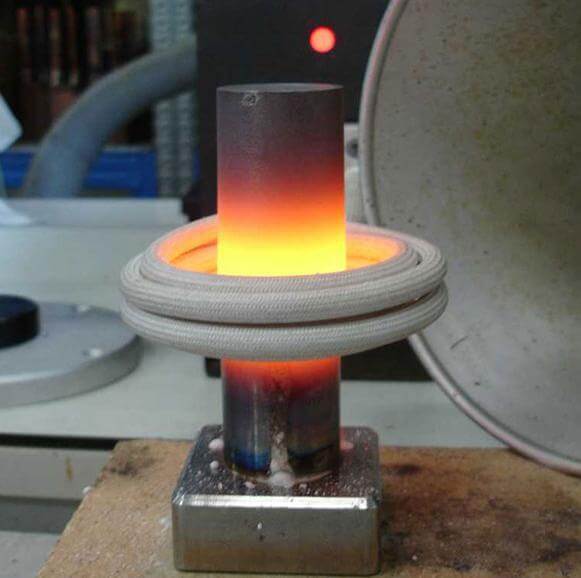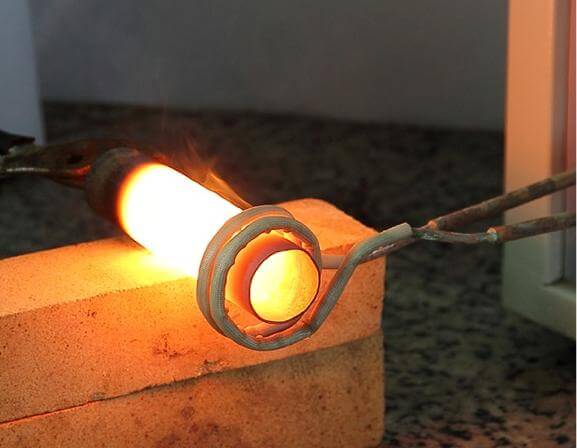Do induction heaters use a lot of electricity?
Induction heaters have gained significant popularity across industries and workshops due to their precision, efficiency, and safety in heating materials. However, one question that frequently arises is whether induction heaters consume a lot of electricity.
In this article, we’ll explore how induction heating works, compare it to traditional heating methods, examine its typical electricity consumption, and answer the critical question of energy efficiency.
What’s Inside an Induction Heater?
An induction heater converts standard AC line power into a high-frequency alternating current, which is directed through a specially designed cable to a workhead containing a series of capacitors and a custom-designed work coil.
This combination works based on the principle of electromagnetic induction, which creates a powerful electromagnetic field within the coil. The field then directly transfers energy to the material placed inside it, heating it efficiently.
The workpiece, typically made of metal, sits within this electromagnetic field. As the current flows through the material, it induces eddy currents, which create heat due to the material’s electrical resistance.
This process ensures that the material itself gets heated without any direct contact with the heating source. Induction heaters also typically use a water cooling system to keep the coil and components from overheating.
How Does Induction Heating Work?
Induction heating is a method of transferring energy to materials without using a flame or direct heat source. Instead, it relies on electric currents and magnetic fields to generate heat.
When an electric current passes through the coil of an induction heater, it creates a rapidly alternating magnetic field. This field induces currents in the metal workpiece, known as eddy currents.
These currents work against the natural electrical resistance of the material, producing heat in the process.
This method is somewhat like rubbing two sticks together to start a fire — but instead of physical friction, it’s the resistance of electrons in the material that generates heat.
The advantage of induction heating is that it heats only the targeted area of the material, without affecting the surrounding areas, and does so rapidly and precisely.
Induction Heating vs. Traditional Heating Technologies
When it comes to efficiency, induction heaters significantly outperform conventional methods such as gas torches, ovens, or resistance heating.
Higher Efficiency: Induction heating systems typically operate with 65–90% efficiency, compared to just 5–15% for traditional ovens.
Faster Heating: Induction delivers heat directly into the metal, cutting down warm-up times dramatically.
Energy Savings: Studies show induction can save up to 50% in energy costs compared to flame or oven heating.
Reduced Scrap: Since heat is applied only where needed, fewer parts are damaged, leading to lower waste rates.
Example: In automotive manufacturing, curing adhesives in a car hood with induction uses only 340 kWh at 65% efficiency. A conventional oven performing the same job consumes around 4,000 kWh at just 5.5% efficiency.
Typical Electricity Usage of Induction Heaters
Induction heaters are generally considered energy-efficient, but their actual power consumption depends on several factors, including the power rating of the unit, the heating time, and the material being heated.
Typically, induction heaters use direct electrical power to generate an electromagnetic field, and the material is heated directly, which minimises energy waste.
For instance, in applications like plastic injection moulding, induction heating has been shown to improve energy efficiency by heating the material directly in the machine’s barrel. This reduces the warm-up time and the overall electricity required. The efficiency varies depending on the material being heated.
Ferrous materials, such as iron, heat efficiently, achieving over 90% efficiency in many cases, while non-ferrous materials like copper have lower efficiency, around 15%. Despite these differences, induction heating remains an energy-efficient solution for most industrial applications.
Is Induction Heating Better Than Other Methods?
Before induction heating became common, industries relied on flame-based heating methods like oxyacetylene torches or batch ovens.
While these methods were effective, they often resulted in inefficiencies and safety concerns. One of the major drawbacks of using a flame for heating is the lack of precision. With an open flame, heat is often distributed over a larger area, risking damage to surrounding components.
Furthermore, using a flame can create dangerous safety risks, requiring additional training for workers and extra safety measures, such as protective equipment and proper ventilation.
In contrast, induction heaters provide a much more precise heating method. The ability to focus heat on a specific area without affecting other components is a major benefit.
This is especially useful when heating materials that are in hard-to-reach areas or when you need to avoid collateral damage to nearby parts.
Induction heaters also run on electricity, eliminating the need for gas and associated risks, further improving safety in the workplace.
FAQs About Induction Heater Electricity Usage
Do induction heaters consume less electricity than traditional methods?
Yes, induction heaters are energy-efficient and generally consume less electricity than conventional heating methods. They generate heat directly within the material, minimizing energy waste.
However, electricity usage depends on the power level and duration of heating required for each application. With proper settings, induction heating can be a cost-effective choice.
How efficient is induction heating?
Induction heating offers remarkable efficiency. It is ten times more efficient than conventional ovens, especially in applications like curing adhesives in automobile hoods.
Typically, induction heating requires 340 kWs from the mains net, achieving an efficiency of 65%. In contrast, conventional ovens use around 4,000 kWs per hood, resulting in only 5.5% efficiency.
What frequencies are best suited for induction heating applications?
The best frequencies for induction heating depend on the specific application and material being heated. Generally, higher frequencies are used for smaller parts or surface heating, while lower frequencies are suitable for larger parts or deeper heating. Selecting the appropriate frequency ensures optimal efficiency and effectiveness.
What are the space requirements for induction heating?
Induction heating requires less space compared to many traditional heating methods. This technology is suitable for bench-top or work cell environments and can be integrated into in-line semi or fully automated processes. Its compact nature makes it ideal for various industrial applications.
Does Induction Heat Magnetic Materials?
If your work piece material is magnetic, such as carbon steel, it will be heated easily by induction’s two heating methods, eddy current and hysteretic heating.
Hysteretic heating is very efficient up to the Curie temperature (for steel 600°C (1100°F)) when the magnetic permeability reduces to 1 and the eddy current is left to do the heating.
Can induction heating be used in automated processes?
Yes, induction heating is well-suited for automated processes. Its precise and controlled heating capabilities make it ideal for integration into semi or fully automated systems.
This adaptability enhances production efficiency and consistency in various industrial applications.
How does induction heating impact power consumption during idle times?
Induction heating technology is designed to be energy-efficient even during idle or stand-by conditions. Power consumption is greatly reduced when the system is not actively used for the intended process. This feature ensures that you save energy and reduce costs when the equipment is not in operation.
Is Coil Design Important in an Induction Heating System?
The efficiency of an induction heater is maximized if the work piece can be placed inside the induction coil. If your process won’t allow your work piece to be placed inside the coil, the coil can be placed inside the work piece.
The size and shape of the water-cooled copper induction heating coil will follow the shape of your work piece and be designed to apply the heat to the correct place on the work piece.
What are the environmental benefits of using induction heaters?
Induction heaters offer several environmental benefits. They use electricity as an energy source, avoiding emissions associated with fossil fuels. Additionally, their high efficiency reduces overall energy consumption, contributing to a lower carbon footprint and promoting sustainability.
How does induction heating affect product quality?
Induction heating provides precise temperature control, which enhances product quality. The ability to target specific areas for heating ensures uniformity and consistency, reducing defects and improving the overall quality of the finished product.
Are there safety considerations when using induction heaters?
Yes, safety is a priority when using induction heaters. These devices operate at high temperatures and involve electrical components. It is essential to follow safety guidelines, use appropriate protective equipment, and ensure proper ventilation to prevent accidents and ensure safe operation.
How to Maximize the Efficiency of Your Induction Heater?
To ensure your induction heater operates at its highest efficiency, here are some effective strategies you can implement:
Optimize Power Settings: Tailor the power level to the specific requirements of your application. Avoid using unnecessary excess power, as this can waste energy.
Minimize Heating Duration: Reducing the amount of time your heater is on helps cut down on energy consumption. Focus on achieving the target temperature as quickly as possible.
Choose the Right Coil: The shape and size of the coil should align with the dimensions of your workpiece. A properly sized coil ensures maximum energy transfer and minimizes heat loss.
Perform Regular Maintenance: Keep your induction heater in top working condition by regularly inspecting and servicing it. Routine maintenance helps ensure long-lasting performance and reduces the likelihood of inefficient operation.
By incorporating these strategies into your routine, you’ll not only boost the efficiency of your induction heater but also enhance its cost-effectiveness and performance longevity.
KEXIN’s induction melting furnace has higher thermal efficiency and lower energy consumption. They can produce a mild metal bath mixture, mixing a uniform alloy at a constant and uniform temperature. For these reasons, this type of furnace is the first choice for induction melting. Kexin products can flexibly meet all customer requirements.
Can we help you?
 Whatsapp
Whatsapp


